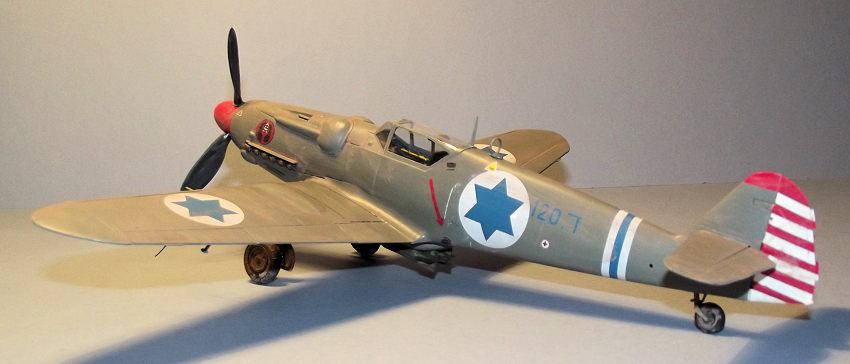
Revell/AML 1/32 Avia S.199
| KIT #: | 32-006 |
| PRICE: | £26-00 |
| DECALS: | Five options |
| REVIEWER: | Frank Reynolds |
| NOTES: | Conversion for Revell 1/32 Bf-109G-6. Above price & # for the conversion set. |

| HISTORY |
During World War 2
Germany established a production facility for the Me109G-14 in Czechoslovakia
and following the defeat of the Nazis, the Czechs continued production of the
type as the Avia S-99. A fire at a storage facility wiped out their stocks of
DB-605 engines, which curtailed production after only 20 aircraft had been
completed, so the resourceful Czechs adapted the airframe to accept what was
essentially a bomber engine, the Junkers Jumo 211F, married to a VS 11 paddle
blade propeller. The ne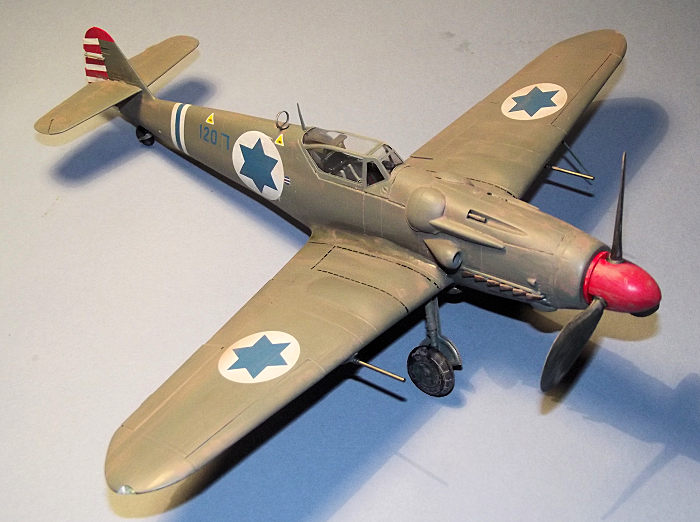 w version was the Avia S-199. In service the aircraft
proved to be a handful; the basic 109 was known to have challenging handling
characteristics, especially on take-off and landing. The S-199 was even worse,
soon being dubbed “Mule”or “Mezec” by its operators, yet over 600 were produced
by Avia in Prague and by Letov on a second production line
w version was the Avia S-199. In service the aircraft
proved to be a handful; the basic 109 was known to have challenging handling
characteristics, especially on take-off and landing. The S-199 was even worse,
soon being dubbed “Mule”or “Mezec” by its operators, yet over 600 were produced
by Avia in Prague and by Letov on a second production line
The new state of Israel came into being in 1948 and was immediately plunged into war with its Arab neighbours. Israel was desperate to acquire whatever aircraft it could from all available sources and in so doing acquired 24 S-199s which served primarily with 101 Sqn. They were dubbed “Sakeen” or “Knife” in Israeli service. At the time they were Israel’s only true combat aircraft, serving in both air to air and air to ground roles. The Sakeens were credited with downing six enemy aircraft, including two Egyptian Spitfires. The first four S-199s were taken into service in May 1948 but attrition rates were high and the last survivors were phased out of front line service by May 1949.
Lou Lenart, an ex-USMC pilot is quoted by Shlomo Aloni as describing the S-199 thus: “It was the worst airplane that I have ever had the misfortune to fly.”
| THE KIT |
The conversion set promised to be a high quality product. The small well packed box was lined in bubble wrap and a card insert. 26 crisply cast resin parts were protected by a series of zip lock bags. There was a small fret of etched stainless steel and printed instrument dials. Instructions consist of a four page A5 booklet setting out a parts chart and colour references keyed to FS numbers and paints by Humbrol, Gunze Sangyo, Lifecolor and Agama. Exploded view sketches show how the conversion parts are to be blended onto the Revell airframe but should be read in conjunction with Revell’s instructions, so some careful planning is recommended. It is clear that the conversion is designed to need a minimum of alteration to the basic kit.
 A substantial
A5-size decal sheet, produced by AML themselves, contains everything needed to
complete the scheme of the builder’s choice including national insignia,
fuselage striping, wing walks, rudder stripes, unit badges and stencilling. Six
choices of aircraft are on offer, with one exception they are all finished on
overall RLM 02 Green/Grey the exception having Sand Brown with shaded Green
upper surfaces and medium Blue under surfaces.
A substantial
A5-size decal sheet, produced by AML themselves, contains everything needed to
complete the scheme of the builder’s choice including national insignia,
fuselage striping, wing walks, rudder stripes, unit badges and stencilling. Six
choices of aircraft are on offer, with one exception they are all finished on
overall RLM 02 Green/Grey the exception having Sand Brown with shaded Green
upper surfaces and medium Blue under surfaces.
The resin conversion parts essentially consist of replacements for, or additions to, Revell items. Direct replacements are provided for the engine’s side and upper cowls and the large bulges for the cannon breeches. New large upper wing bulges are included, together with the blunt nose cowl front, spinner with three huge propeller paddle blades and a multiple bomb carrier for the wing centre section. A pair of underwing gondolas is provided for the “gun boat” installation.
The builder is expected to use most of the Revell G-6 kit including the upper wing, wheels, exhausts, cowl side intake - all of which may be a less than perfect choice, as I was to discover.
| CONSTRUCTION |
I prefer to cut,
trim and sand all of the resin parts at an early stage so that they can be built
into the airframe with a minimum of fuss. So armed with a brand new razor saw
blade, a new dust filter mask and some wet and dry abrasive paper I set to work.
The potential dangers of resin dust are well known so a good mask and good
ventilation are essential. The clean castings and good definition of the cut
lin es made the work straight forward. Some patient trimming and sanding was,
however, required to the joining faces since the major castings have a
strengthening bar cast over the edge and these need to be smoothed away .The
resin parts were then washed in a mild detergent solution and left to dry
overnight.
es made the work straight forward. Some patient trimming and sanding was,
however, required to the joining faces since the major castings have a
strengthening bar cast over the edge and these need to be smoothed away .The
resin parts were then washed in a mild detergent solution and left to dry
overnight.
Construction can follow the sequence set out in Revell’s instructions but I marked up where deviations should occur in order to accommodate the resin parts. I examined all of the parts carefully to establish whether there were any time-saving cheats available to me and thanks to a well-stocked spares box from a previous run of 1:32 Me109s I sourced a number of plastic parts that I could put to use. This is not to say that AMLs resin parts are of no use, far from it, for they offer a package that is as comprehensive as anything on the market and nothing further needs to be bought. It is just that I am lazy and I will always prefer my builds to have plastic to plastic joints where possible.
A minor disadvantage with AML’s design is the wing modification. They provide resin fairings to slip on top of the Revell wings to form the later pattern wheel housing. However the interior of the wheel wells will retain the early pattern shallow dish effect in the well roof and, perhaps more crucially, the narrow pattern wheels. Aftermarket wheels will need to be sourced or another solution found.
By happy chance I already had an example of Revell’s 109G-10 “Erla” in my stash and although it was clear that AML’s conversion could not be easily grafted onto the G-10’s different nose contours, Revell’s use of common parts frames ensured that it was possible to steal the inner upper wing panels and wide wheels from the G-10 and trade the small bulge/thin wheel parts back to the G-10 for a later project.
With the wing mods
duly sorted, I also retired the resin cast centre section bomb carrier to the
spares box and substituted a plastic version from an Eduard accessory set.
Similarly the under wing cannon pods were replaced with Trumpeter mouldings. I
have learned from discussions on the web that the exhausts for the Jumo engine
are different from those on a 109’s DB engine but AML do not address this. From
my ow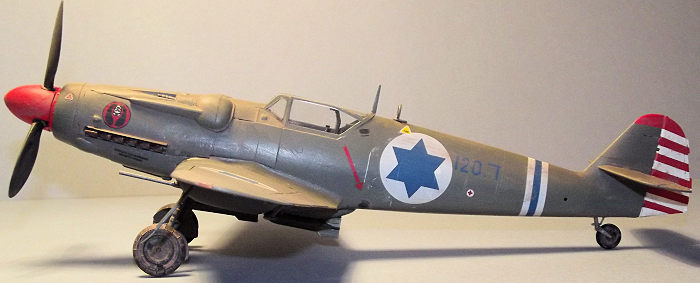 n examination of photos, Revell’s offering looks to be near enough for my
purposes.
n examination of photos, Revell’s offering looks to be near enough for my
purposes.
The next order of business was to revisit the Revell parts frames and harvest all of the parts that I would not need, carefully storing them in self-seal bags just in case I had got my choices wrong.
Construction begins with the cockpit tub and Revell provides a good set of basic mouldings which builds up as a main floor, rear bulkhead with seat pan and well detailed cockpit side walls with throttle, trim wheels and separately moulded pipework and cables. The plastic parts have a representation of seat belts moulded in but these can be covered over when AML’s etched steel belts are fixed in place with cyano glue. A replacement resin floor box is fixed between the rudder pedals. I elected to use plastic pedals rather than etched steel items. The steel fret provides a new instrument panel which is backed with a thin clear plastic printed sheet with instrument detail. The basic colour of the cockpit interior was sprayed in Xtracrylix XA1203 RLM66 Schwarzgrau Matt. The seat belts were brush painted light sand and a further touch of colour introduced by picking out the pipes and wires to the side walls in yellow, silver and blue according to Revell’s call outs. The substantial wing spar was glued under the cockpit floor and the sub assembly side aside to harden.
The short tail wheel configuration was selected from AML’s choices with the forks and internal support tubes painted in RLM Grau 02 XF-22 from Tamiya’s Acrylic range.
The two fuselage halves were modified by cutting 7.5mm off the nose to accommodate the resin plug which forms the blunter nose profile. The engine exhausts were painted Red Brown and glued in place from the inside of the lower cowls. The kit is engineered in such a way that I could not figure out a means of adding them later in the build. The two fuselage halves were joined by threading them onto the wing spar and around the cockpit tub, not forgetting the trap the tailwheel support tube inside the fuselage. The fuselage assembly was strapped up with sticky tape and left for a few days to harden.
The forward
fuselage has an open framework to which the cowl panels are attached. One of the
more obvious characteristics of the S.199’s layout is the relocation of the
109’s large side mounted supercharger intake from the left to the right side of
the engine. AML have cast new panels which allow for this, but in other respects
they are the same. I elected to keep the left side cowl as a plastic item and it
was 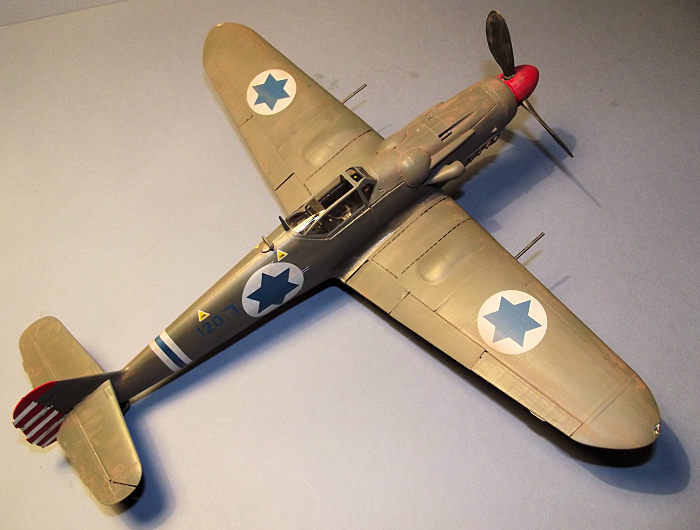 a straightforward job to carve away the supercharger seating, fill the hole
with an offcut of plastic card, fill and sand smooth. Before the cowl panels are
added it is useful to fix the lower resin insert that provides either a large
cooler scoop or shallow oil cooler panel according to which version you choose.
I went for the smaller version and it is certainly easier to work this lower
panel into place through the open nose structure. The resin right hand nose
panel was tacked into place with cyano glue and the new blunter nose section
using the same adhesive. With the top cowl yet to be added, the resin to plastic
joints were strengthened from the inside with a smear of quick setting epoxy.
The top cowl was added next. I found it to be about 1.5mm too short, possibly as
the result of shrinkage so I lined it up with the front of the cockpit, leaving
a gap in the nose area that was filled with offcuts of plastic card, sanded to
shape and refined with an application of Squadron Green Putty. Left to settle
for a couple of days, the fuselage was completed with the installation of the
massive cowl bulges which are cast with their very distinctive tapering forward
extension, followed by two small bulges to the lower corners of the nose.
a straightforward job to carve away the supercharger seating, fill the hole
with an offcut of plastic card, fill and sand smooth. Before the cowl panels are
added it is useful to fix the lower resin insert that provides either a large
cooler scoop or shallow oil cooler panel according to which version you choose.
I went for the smaller version and it is certainly easier to work this lower
panel into place through the open nose structure. The resin right hand nose
panel was tacked into place with cyano glue and the new blunter nose section
using the same adhesive. With the top cowl yet to be added, the resin to plastic
joints were strengthened from the inside with a smear of quick setting epoxy.
The top cowl was added next. I found it to be about 1.5mm too short, possibly as
the result of shrinkage so I lined it up with the front of the cockpit, leaving
a gap in the nose area that was filled with offcuts of plastic card, sanded to
shape and refined with an application of Squadron Green Putty. Left to settle
for a couple of days, the fuselage was completed with the installation of the
massive cowl bulges which are cast with their very distinctive tapering forward
extension, followed by two small bulges to the lower corners of the nose.
Attention now turned to the wing structure and Revell have a very specific build sequence that is worth following. The inner panels of the upper wing are glued in place first, sitting on the wing spar and butting up to the wing root. Radiator faces and side walls to the wheel wells are added underneath to form a strong centre section. The lower wing is one piece from tip to tip and thanks to Revell’s good engineering slipped into place without fuss. The upper wing outer panels were added to complete the basic wing structure.
The upper parts of the tail fin and horizontal tail sections were added to complete the basic airframe. Leading edge slats, elevators, ailerons and wing flaps are all separately moulded and could be posed deflected if required. I chose to fix them all closed up. The rudder was to be a different colour finish from the main airframe so it was more convenient to deal with it later in the build.
Once all the glue
had dried I treated the main joints of the airframe to a hand brushed coat of
dark grey acrylic paint which is useful as a form of soft filler and a means of
highlighting any joints which are misaligned. All of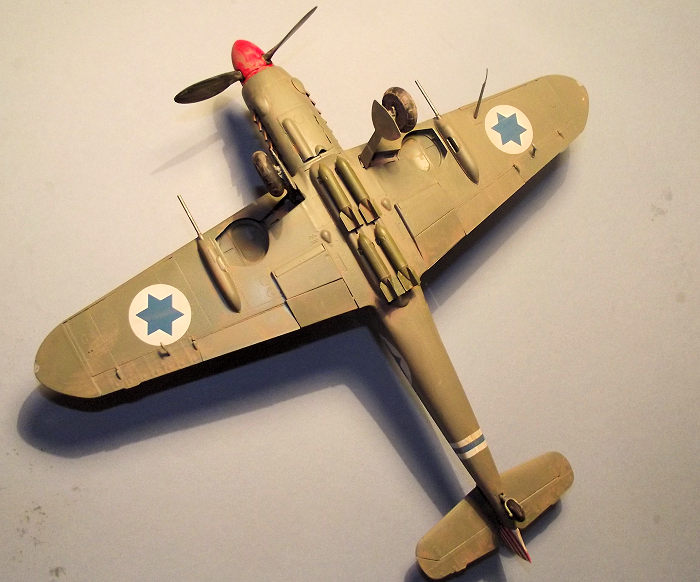 the hand brushed paint was
gently buffed away with sanding sticks so that any remaining areas of dark paint
showed up areas where a touch of filler was needed. I had left off the large
intake on the right hand cowl side to give clear access to the panel joints and
it was then added. A check of photos suggested that the supercharger intake for
the Jumo engine is larger than that of a 109G-6, so I went back to my spares box
and found a K-4 type that probably originated from Trumpeter mouldings.
the hand brushed paint was
gently buffed away with sanding sticks so that any remaining areas of dark paint
showed up areas where a touch of filler was needed. I had left off the large
intake on the right hand cowl side to give clear access to the panel joints and
it was then added. A check of photos suggested that the supercharger intake for
the Jumo engine is larger than that of a 109G-6, so I went back to my spares box
and found a K-4 type that probably originated from Trumpeter mouldings.
The canopy and windscreen were glued in place. The canopy has small side hinges moulded in that need to be trimmed away if a closed version is chosen. The armour headrest was painted Dark Grey and carefully fixed inside the canopy frame with Humbrol ClearFix. The canopy exterior was masked with Tamiya tape trimmed to fit with a fresh scalpel blade. The large bomb carrier under the wing centre section was glued on the complete construction of the main airframe.
Suitably tidied and re-sanded the entire airframe was primed with Grey Auto Primer from a rattle can.
| COLORS & MARKINGS |
This was a good time to catch up on some sub-assemblies. Thankfully the gear legs can be assembled and painted separately and are a positive plug fit. Normally I would paint gear legs in Grau 02, but in view of the planned finish to the airframe the main and tailwheel legs were painted Dark Grey, the wheel hubs Black and the tyres Tamiya XF-85 Rubber Black.
The rudder was undercoated in Tamiya White Fine Primer from a spray can and the propeller and spinner assembly with the same. I intended to use the decal for the Red and White stripes to the rudder but I found that the first one to be applied was ultra-thin, and as the result of my mis-handling, folded up, cracked and tore immediately on application and was scrap. Using the remaining decal as a pattern, the rudder was masked up with Tamiya tape and the red stripes sprayed on with Tamiya XF-7 Red, while the same colour was used to decorate the propeller spinner. The blades were painted in Schwarzgrun XF-27.
 Masking the rudder
proved to be the most complex part of the painting, for the rest of the airframe
was sprayed in RLM Grau 02, XF-22 and lots of it, applied with my trusty Iwata
HP-C airbrush.
Masking the rudder
proved to be the most complex part of the painting, for the rest of the airframe
was sprayed in RLM Grau 02, XF-22 and lots of it, applied with my trusty Iwata
HP-C airbrush.
While the airbrush was charged up with Grau 02, the remaining small parts on the frames were painted up, the gear doors, aerials and aileron mass balances.
The airframe was sealed with two coats of Future/Klear applied with a No 5 paint brush, to provide a gloss base for the decals, hopefully to provide plenty of slip and slide on application and avoid the destruction that had occurred with the rudder stripes. Having learned the hard way just how fragile the decals could be, each decal was carefully floated into place on a small puddle of Micro Set and gently pressed down with a paper towel. Left overnight to settle, the decals were sealed in with two further hand brushed coats of Future/Klear, then two finely misted airbrushed coats of Xtracrylix Flat varnish to provide a dull matted finish. Some Tamiya X-19 Smoke was loaded into the airbrush and at a low pressure setting was ghosted around the exhaust stacks and back along the fuselage sides above the wing roots to provide a hint of exhaust staining.
The gear legs were glued into positive locations on the wheel wells and although the gear doors proved to be a bit of a fiddle, they were eventually installed to my satisfaction. The build was completed with the installation of the aerials, aileron balances, tailwheel and the underwing cannon pods. Four bombs were added under the centre section. These came from the Eduard accessory set and were painted in US Olive Drab to provide a bit of contrast.
Left a couple of days to settle, the whole model, apart from the glazing, was sloshed over with Promodeller Weathering Wash, Mud Brown, applied with a wide soft brush. This dried to a dead matt finish and was carefully wiped away with piece a just-damp plastic sponge to leave the sort of dusty mud-caked appearance that an overworked warplane might exhibit in a Middle Eastern environment.
| CONCLUSIONS |
Although apparently unwanted and unloved by any pilot asked to fly it, the Sakeen is a welcome addition to my collection
 The total cost of
£43-00 is very reasonable for a 1:32 fighter. The conversion set has just about
everything you need.
The total cost of
£43-00 is very reasonable for a 1:32 fighter. The conversion set has just about
everything you need.
Many similar conversions provide a new nose formed from one hefty block of resin and it is to AML’s credit that they have formed the new nose from thin panels to make the whole thing more manageable. The fact that I chose to incorporate some plastic from other manufacturers is just a personal preference.
I cannot judge if every panel line and every rivet is correct, I’ll leave that to the 109 fans/obsessives out there on the wider web; I just thoroughly enjoyed this project.
This is a package that has great potential for those who have more talent than I possess, yet is suitable for a first attempt at a conversion because the basic requirement is so simple – take a Revell 109, shorten the nose a bit, then add some well -crafted resin parts and paint it all over in one colour.
Highly recommended to all.
| REFERENCES |
Messerschmitt Bf109, The Operational Record, by Jerry Scutts, Airlife Publications, 1996.
Year of the Mule, Avia S 199 Mezecs in Israeli Service by Shlomo Aloni, Air Enthusiast Quarterly No 59, Spring 1995. Key Publishing.
Israeli Air Force, by Yehuda Borovik, Warbirds Illustrated No 23, Arms and Armour Press, 1984
11 July 2017
Copyright ModelingMadness.com
Project courtesy of my wallet.
If you would like your product reviewed fairly and fairly quickly, please contact the editor or see other details in the Note to Contributors.
Back to the Main Page Back to the Review Index Page Back to the Previews Index Page